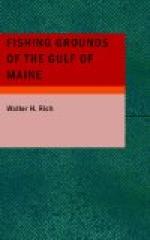This bank is now mainly an Italian boat ground and is used by small craft from Boston and Gloucester. Gill-netting here is especially extensive in November and December, mostly for pollock. Netters operate about 22 miles SSE. from Eastern Point in 22 to 25 fathoms on a hard bottom. Good pollock catches are made in 25 to 40 fathoms on the eastern and southeastern slopes in the latter part of November and early December. Haddock are here from November 1 to March 1 and from April 20 to May 15. Cod are present all the year, the largest school occurring during August, September and October. It is a cusk ground from November to March in the deeper water. What seems a somewhat unusual occurrence in these later years was the appearance of a considerable school of halibut on the northern slope of Stellwagen during the last half of April 1926, several small craft getting from 2,000 to 3,000 pounds in their fares.
Wild Cat Ridge. Very heavy tides sweep over this ground, making it difficult to haul gear in fishing upon it, whence, it is said, comes the name. It lies NNE from Highland Light, Cape Cod, 18 miles to its southern edge; Se 1/2 S from Thacher Island 31 miles; and is about 7 1/2 miles long in a north and south direction by about 3 1/2 miles wide. The bottom is hard, of broken shells and sand, and depths are from 45 to 60 fathoms. There are 100 fathom depths inside of the ground and from 100 to 110 fathoms outside of it. Apparently, this is an all the year ground for cod, cusk, and haddock, although but little fished at any time other than the winter seasons.
[Table 3—Outer Fishing Grounds, showing the principle species taken upon them.]
[Footnote 13: There has been some speculation as to the origin of the somewhat unusual name of this bank. The writer would note that there was an Edward Tillie in the Company of Captain John Smith when he explored this region in 1614 and a Tilly (perhaps the same person) who operated a fishing station at Cape Ann during the years 1624 and 1625.]
GEORGES AREA
East side of Cape Cod. The sea bottom off the east side of Cape Cod is mainly sandy and slopes off gradually from the beach, reaching depths of 30 to 40 fathoms at 5 to 7 miles from land. Below Chatham the slope is even more gradual. Within these limits good catches of cod are taken occasionally, and to a less extent the same is true of haddock. Farther from the shore, in from 40 to 80 fathoms and from a point 8 or 10 miles off the Highlands of Cape Cod to another point lying 20 miles or more SSE. from Chatham Lights, is a continuous stretch of excellent haddock grounds for winter fishing. The deep water off Chatham furnishes excellent hake fishing in summer and fall.
This shore furnishes excellent mackerel fishing during most of the season when these fish are in northern waters. Virtually no gill-netters operate here, the distance to market being great and the chance of rough weather and the lack of safe harbor making it dangerous for small craft. From this stretch of shore (mostly from off Chatham) there were landed at Boston in the year 1923, 66 fares with a total of 1,797,826 pounds valued at $76,875.




